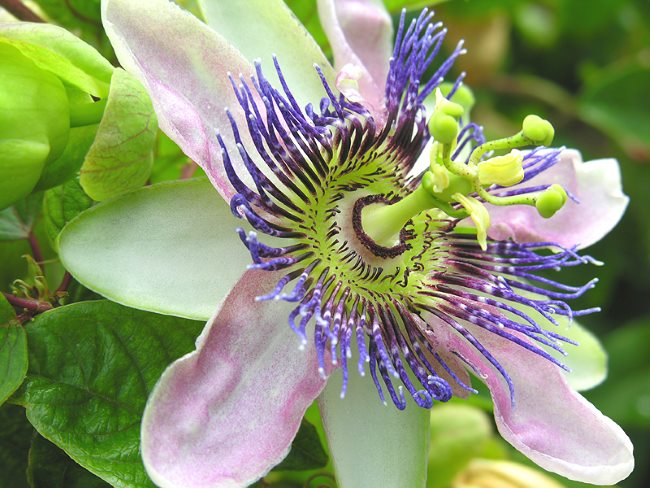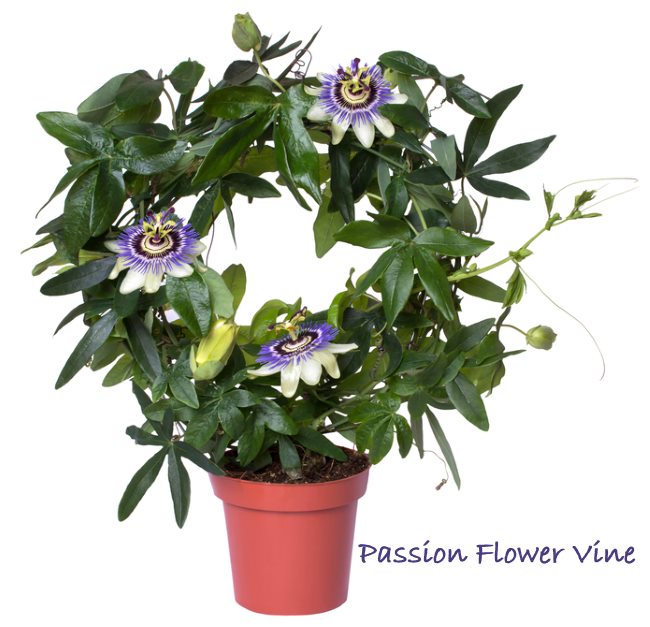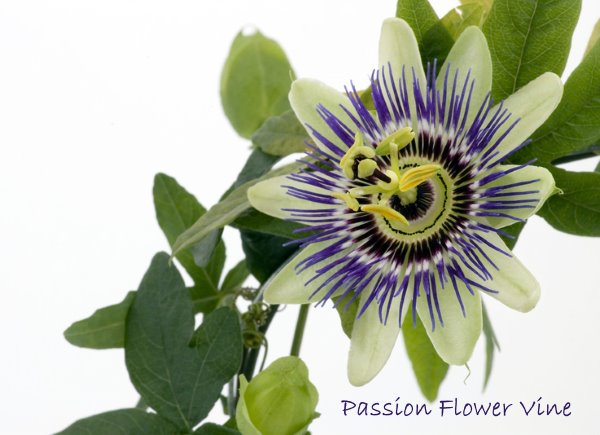Passion Flower Vine
Botanical Name: Passiflora caerulea
Passion Flower vine is immediately recognizable by its big, spectacular blooms that appear in late summer and fall.
Those unusual blue and white flowers are about 4-6 inches (10-15 cm) across. Five petals, five sepals, and fine violet-blue filaments surround prominent green anthers, making passion flowers among the most extraordinary and exotic-looking you'll find anywhere.
After a long, hot growing season outdoors, the flowers are followed by small yellow or orange egg-shaped fruits that are edible but full of seeds. But don't expect it to bear fruit indoors.

A few Passion Flower facts will help you know and grow this plant.
It is native to the South American rain forests where it clings to the trunks of trees using its tendrils.
Indoors, this tropical plant needs warmth, direct sun and humidity to grow well. Because of its need for full sun and high humidity, it can be somewhat difficult to please in a home and will grow best in a greenhouse.
Train Vines on a Trellis or Hoop
Those fast-growing, vigorously climbing vines are thickly covered with lobed dark-green leaves.
To show off its leafy vines, and to give them a denser appearance, loop them around a wire hoop or trellis and tie loosely with florists wire. You can trim vines as you go. Pruning passion flower vine does no harm and will help keep it under control.
 Passion flower's vines grow on a hoop indoors. Photo ©Liudmyla Ivashchenko
Passion flower's vines grow on a hoop indoors. Photo ©Liudmyla IvashchenkoHow to Prune Passion Vines
Cut the stems back in spring, just before its heaviest blooming time, but be careful not to remove any flower buds. Use sharp pruners to avoid tearing the stems. You can cut stems down to 10-inches (25 cm) long, if you want.
Overwintering Passion Flower Plant
This South American beauty needs a winter rest.
When the flowering season is over, reduce watering and stop fertilizing. Give your plant cooler temperatures, as low as 50°F/10°C during this rest. Low light levels are fine. When spring begins, resume normal care.
When to Repot
Repot young plants in spring, when plants are beginning their most vigorous growth. Older plants can be top-dressed instead, removing the top couple inches (5 cm) of soil and replacing it with fresh soil. Don't overpot -- you'll get the most flowers if its roots are a bit crowded in the pot.
Something Bugging Your Plant?
Dry indoor air can sometimes attract spider mites to houseplants. You'll first notice their fine webbing between stems and leaves. Spider mites are extremely tiny and hard to spot -- they're about the size of pepper flakes -- but they can do a lot of damage by sucking plant juices. Treat any infestation immediately and isolate an affected plant to prevent these tiny critters from invading your other houseplants.
Raising the humidity around your plant can help to prevent them.

Where to Buy Passion Flower
You'll find Passion Flower for sale in tropical and sub-tropical regions in spring and summer, and nearly year-round at some online garden sites that offer tropical plants.
Passion Flower Vine Growing Tips
Origin: South America, from Brazil to Argentina
Height: Up to 10 ft (3 m) if not pruned back
Light: At least 4 hours of direct sunlight a day will promote blooming. It does best in a south-facing room, sunroom or greenhouse. If you don't have a sunny spot for it, use a grow light. Keep grow lights on for 12 to 14 hours a day. Remember to turn off the lights at night; plants need their rest, too.
Water: Keep potting mix evenly moist from spring through fall. In winter, provide just enough water to keep mix from drying out.
Humidity: Requires moist air (around 60% relative humidity). Indoor air can become extremely dry indoors; it's a good idea to use a humidity monitor near your plant rather than guess. Keep your plant away from heat/AC vents that can be drying. To raise humidity, set pot on a tray of wet pebbles or use a cool-mist room humidifier. Brown leaf tips are a symptom of dry air.
Temperature: 55-60°F/13-16°C nights and 70-75°F/21-24°C days. To ensure blooming, give your plant slightly cooler nighttime temperatures. A 15° difference will do.
Soil: Good-quality, all-purpose potting mix
Fertilizer: Feed with a liquid fertilizer diluted by half once a month spring through fall. I highly recommend organic fertilizer that's safe for indoor plants. Do not feed in winter.
Propagation: Take 6 in (15 cm) stem tip cuttings in summer and root in moist potting mix. Keep cuttings warm with a seedling heat mat.


